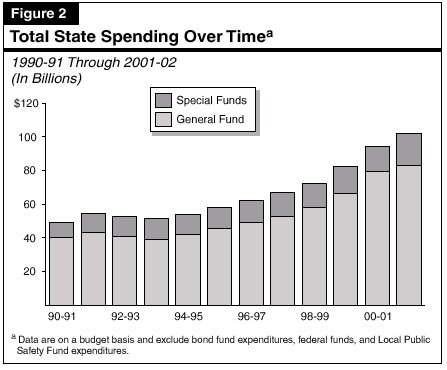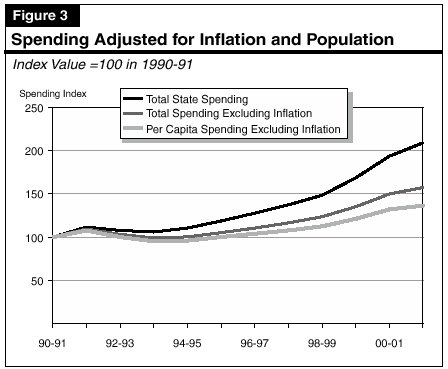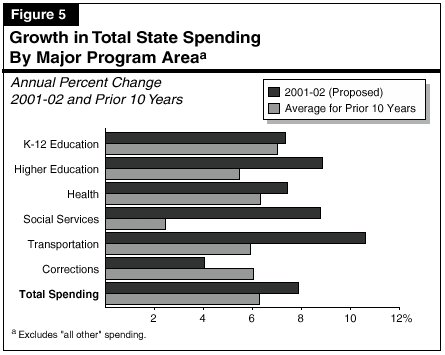Analysis of the 2001-02 Budget BillLegislative Analyst's Office
|
The Governor's budget proposes total spending in 2001-02 of $102 billion, including spending from both the state's General Fund and its special funds (see Figure 1). This total budget-year spending is 7.9 percent more than the $94.6 billion proposed for the current year. Of total budget-year spending, General Fund spending accounts for slightly more than 80 percent.
| Figure 1 | ||||
| Governor's Budget Spending Totals | ||||
| 2000-01 and 2001-02 (Dollars in Millions) | ||||
| Change | ||||
| 2000-01 | 2001-02 | Amount | Percent | |
| Budget Spending | ||||
| General Fund | $79,708 | $82,853 | $3,145 | 3.9% |
| Special fundsa | 14,843 | 19,163 | 4,320 | 29.1 |
| Totals | $94,551 | $102,016 | $7,465 | 7.9% |
| a Does not include Local Public Safety Fund expenditures of $2.3 billion in
2000-01 and $2.4 billion in 2001-02. These amounts are not shown in the
Governor's budget. Detail may not total due to rounding. | ||||
Background. The General Fund is the predominate source of support for state programs, and thus finances a wide variety of activities. For example, it is the major funding source for K-12 and higher education programs, health and social services programs, youth and adult correctional programs, and tax relief.
The General Fund is primarily funded from tax revenues. As discussed in "Part III" of this volume, three taxes are projected to account for 95 percent of the total General Fund revenues in the budget year. These taxes are the state's personal income tax, sales and use tax (SUT), and bank and corporation tax.
Proposed Spending. In 2001-02, the Governor proposes General Fund spending of $82.9 billion. This is up $3.1 billion from the current-year's proposed amount of $79.7 billion a relatively modest 3.9 percent growth compared to the exceptionally strong 15 percent to 20 percent increases experienced in the current and prior years. This modest growth partially reflects the fact that one-time spending in the budget year ($3.3 billion) is less than in the current year ($5.8 billion). After adjusting for the reduced amount of one-time spending, as well as funding shifts and accounting changes, General Fund growth would be higherabout 7.5 percent.
Background. Special funds are used to allocate certain tax revenues (such as gasoline and certain cigarette tax receipts) and various other income sources (including many licenses and fees) for particular functions or activities of government designated by law. Around one-half of the special funds revenues come from motor vehicle-related levies. Other major funding sources include the SUT and tobacco-related receipts, including for the budget year tobacco settlement monies.
Proposed Spending. In 2001-02, the Governor proposes special funds spending of $19.2 billion. This is up by nearly 30 percent from the current-year's proposed total of $14.8 billion. This unusually large increase primarily reflects funding shifts and accounting changes involving vehicle license fee (VLF) reductions, transportation spending, and tobacco settlement funds. Without these anomalies, the budget-year increase would be around 9 percent.
It should be noted that the budget's special funds spending totals exclude expenditures from the Local Public Safety Fund. Although we believe that such spending does constitute state spending, we do not include it in our figures so as to facilitate comparisons with the budget figures.
In addition to the $102 billion of proposed 2001-02 spending from the General Fund and special funds, the budget also proposes $43.5 billion in spending from federal funds and another $2.7 billion from bond proceeds. If expenditures from bond proceeds and federal funds are included in total state spending, 2001-02 spending exceeds $148 billion.
Of the $43.5 billion in federal funds the budget proposes to spend in 2001-02, 75 percent flows through the state budget to local governments in the form of local assistance. The majority of federal funds in the budget are federal contributions to health and social services programs ($27.5 billion, or 63 percent of the total) and education ($10.1 billion, or 23 percent). These program areas account for about 85 percent of total federal money that flows through the state budget. It is, however, important to note that the federal money flowing through the state budget only accounts for just over one-quarter of the $160 billion in total federal funds that California receives annually.
Budgetary Treatment. When the state relies on bond proceeds instead of direct appropriations to fund its capital outlay projects, the use of these proceeds is not itself reported as budgetary spending as it occurs. Rather, the debt-service cost for principle and interest on the bonds is what is recorded as budgetary spending. For 2001-02, the budget's proposed General Fund debt-service costs total $3.3 billion$2.6 billion for general obligation bonds and $656 million for lease-payment bonds.
Although this way of treating bonds makes sense from a budgetary standpoint, tracking bond fund expenditures themselves still is useful as an indication of the actual volume of "brick and mortar" activities going on in a given year with respect to capital projects.
Spending of General Obligation Bond Proceeds. The budget estimates that the state will spend $2.7 billion in general obligation bond proceeds for capital projects in 2001-02. This compares to $6.1 billion in the current year and $2.6 billion in the prior year. The majority of the budget-year bond fund expenditures (over 60 percent) is for various local assistance projects such as K-12 school construction and resource programs. The bulk of the remaining general obligation bond proceeds is dedicated to state-level capital outlay projects, with over 70 percent of the money ($554 million) dedicated to higher education projects in the budget year.
Spending of Lease-Payment Bond Proceeds. In addition to general obligation bonds, the state also uses lease-payment bonds to finance the construction and renovation of capital facilities. Lease-payment bonds do not require voter approval, and their debt service is paid from annual lease payments made by state agencies (funded primarily through General Fund appropriations). For 2001-02, the budget proposes $350 million in lease-payment bonds to finance a capital outlay project for the Department of Mental Health.
Background. In 1979, California's voters established a state appropriations limit (SAL) when they approved Proposition 4. The SAL places an "upper bound" on the amount of tax proceeds that the state can spend in any given year and grows annually by a population and cost-of-living factor. Most state appropriations are subject to the SAL; however, certain appropriations are exempt—including subventions for schools and local governments, capital outlay, and tax relief. If actual tax proceeds exceed the SAL over a two-year period, the excess must be divided among taxpayer rebates and Proposition 98 education funding.
Current SituationNo Effect. For most of the 1990s, spending fell well below the limit due to the recession's adverse effect on state revenues. However, in recent years, rapid spending growth eroded the "room" under the limit until the SAL was exceeded by $702 million in 1999-00.
In 2000-01, however, appropriations subject to limitation will fall $3.7 billion below the SAL. This is primarily due to the large amount of exempt appropriations that were enacted in the 2000-01 budget including school subventions, VLF rebates, capital outlay, and local fiscal relief. Thus, the state will not have excess revenues for the two-year period ending in 2000-01.
State spending is also projected to be well below the SAL in the budget year—by $5.4 billion. This is due to the slowing in General Fund revenue growth to 3.9 percent, which is well below the 9 percent growth projected for the SAL itself.
Prior to looking at the programmatic details of the Governor's spending plan for 2001-02, it is first helpful to provide some perspective on state spending by looking at how the new plan's spending amounts compare to historical trends.
Spending Trends and Their Determinants. Figure 2 shows the amounts of state General Fund and special funds expenditures during the 1990s and compares them to the current and budget years. These trends and their year-to-year variations are affected by a variety of factors. Generally, the most important factor tends to be the strength of the economy and the state revenues it generates to fund expenditure programs. Another key factor involves the decisions policy-makers and voters arrive at that affect spending levels. Among some of the more important of these over the past decade have been the realignment of state and county health-related responsibilities in 1991-92, the imposition of additional cigarette and tobacco taxes due to Proposition 10 (1998), and the manner in which available resources have been allocated between spending priorities and tax relief.
Figure 2 shows that total state spending has roughly doubled over the entire period, with declines during the early-1990s' recession followed by growth thereafter. About half of the total growth has occurred since 1997-98. Figure 3 breaks out the causes for this growth according to its three principal determinants—population growth, inflation in the costs of providing public services, and "real" growth in state programs. It indicates that:


The strong spending growth in recent years has reflected California's extraordinary healthy economy and strong revenue performance, which has provided sufficient resources to undertake a variety of new one-time and ongoing spending commitments.
Figure 4 shows the allocation of the proposed $102 billion of total state spending in 2001-02 among the state's major program areas. Both General Fund and special funds expenditures are included in order to provide a meaningful comparison of state support among broad program categories, since special funds provide the bulk of the support in some areas (such as transportation).

The figure shows that K-12 education receives the largest share of total spendingabout one-third. (It should also be noted that K-12 education receives additional funding from local sources.) When higher education is included, the education share rises to over 43 percent. Health and social services programs account for about 26 percent of proposed total spending, while transportation and corrections together account for roughly 13 percent. In the "all other" category (18 percent), the largest share is for general-purpose fiscal assistance provided to local governments in the form of shared revenues and General Fund payments that backfill losses from VLF reductions.
In order to get a perspective on how total state spending has changed for each broad programmatic area, Figure 5 shows their proposed growth in the budget year compared to the average annual growth in these programs over the past ten years. As noted before, total state spending growth is relatively strong in the budget year (7.9 percent), which is well above the ten-year average growth of 6.3 percent.

Transportation shows the largest increase in programmatic spending in the budget year (10.6 percent), mainly reflecting large increases in special funds spending for capital outlay projects. The increases in health and social services are also above-average, and are largely driven by General Fund spending increases associated with cost-of-living adjustments (COLAs) and expansions in some program elements. The budget also proposes rapid growth in higher education spendingnearly 9 percentwhich is due in part to one-time funding for various capital outlay projects. The percentage increase in total spending on K-12 education—nearly 8 percent—is above the ten-year average, reflecting a large overappropriation of the Proposition 98 minimum guarantee. Growth in total expenditures on corrections in the budget year is relatively small when compared to the ten-year historical average, which is primarily due to slowing caseload growth.
Despite the moderation in total General Fund expenditure growth proposed for the budget year, sufficient resources have been provided to fund existing programs, augment some programs, and propose certain new programs. Figure 6 provides detail by program area for the General Fund spending amounts contained in the budget, while Figure 7 summarizes the budget's key elements and proposals. Most of the new proposals and augmentations are discussed in detail in our accompanying Analysis of the 2001-02 Budget Bill, and some major ones are highlighted in the following section entitled "Major Expenditure Proposals in the 2001-02 Budget." Certain developments in key areas of the budget are briefly discussed below.
| Figure 6 | ||||
| General Fund Spending by Major Program Area | ||||
| 1999-00 Through 2001-02 (Dollars in Millions) | ||||
| Proposed 2001-02 | ||||
| Actual 1999-00 |
Estimated 2000-01 |
Amount | Percent Change | |
| Education Programs | ||||
| K-12 Education |
$27,588 |
$30,311 | $32,540 | 7.4% |
| Community Colleges |
2,552 |
2,819 | 3,048 | 8.1 |
| UC/CSU |
4,891 |
5,826 | 6,397 | 9.8 |
| Other |
577 |
750 | 897 | 19.7 |
| Health and Social Services Programs | ||||
| Medi-Cal a |
$8,065 |
$9,458 | $9,325 | -1.4% |
| CalWORKs |
1,991 |
1,935 | 2,128 | 10.0 |
| SSI/SSP |
2,501 |
2,626 | 2,870 | 9.3 |
| Other a |
5,193 |
6,849 | 7,866 | 14.8 |
| Youth and Adult Corrections |
$4,748 |
$5,181 | $5,389 | 4.0% |
| All Others b |
$8,780 |
$14,659 | $13,144 | -10.3% |
| Totals | $66,494 | $79,708 | $82,853 | 3.9% |
| a The 2001-02 decline in Medi-Cal and increase in the "Other" category is due to a technical shift of $600 million to the Department of Developmental Services and the replacement of $170 million of General Fund spending with tobacco settlement funds. | ||||
| b The 2001-02 decline is primarily due to the magnitude of one-time spending in 2000-01. | ||||
| Figure 7 |
| Major General Fund Expenditure Proposals In the Budget |
 Major funding increases for education. Major funding increases for education. |
Education Funding Remains a High Priority. The main priority of the current administration has been education. Based on the Governor's proposed budget plan for 2001-02, General Fund spending for K-12 education will increase in inflation-adjusted terms by 75 percent since 1990-91. While most of the K-12 education increase over this period reflects the rapid rise in the Proposition 98 minimum funding guarantee during the second half of the 1990s, it also is due to explicit policy decisions to overappropriate the guarantee beginning in 1997-98. The increased K-12 expenditures have primarily been used to fund enrollment growth, COLAs, and various education-related initiatives. In the budget year, $900 million has been proposed for a variety of new spending programs, including a proposal for expanding the middle-school year and for intensive teacher training in math and English language skills.
Spending on higher education has also increased significantly in recent years, due both to enrollment growth and additional monies provided for student fee reductions, building maintenance, new technology grants, and research. New proposals in the budget year continue the theme of strong funding support for higher education, including over $500 million for new capital outlay projects as well as a 5 percent general increase for both the University of California and California State University.
Increased Costs Are Driving Health and Social Services Programs. General Fund expenditures for the state's major health and social services programs are proposed to experience moderate growth in 2001-02. This compares to receiving relatively modest increases throughout much of the past decade, when declining caseloads were occurring. The recent switch to more rapid growth in health care expenditures reflects increased costs and utilization of prescription drugs and services in the Medi-Cal Program, as well as a proposed expansion of the Healthy Families Program. In the case of social services programs, these have contributed to increased General Fund spending in the budget year largely due to COLAs in Supplementary Security Income/State Supplementary Program and technical changes related to the maintenance-of-effort requirement in the California Work Opportunity and Responsibility to Kids program.
Significant One-Time Expenditures. In recent years, the state's extraordinary strong revenue performance, combined with a conscious effort to not overcommit future budgets, resulted in a significant volume of one-time General Fund expenditures. These one-time expenditures have been for a variety of state and local purposes. The Governor's budget proposal continues this trend with over $3.3 billion earmarked for one-time spending in 2001-02. This includes the $1 billion set-aside for energy initiatives along with over $700 million for capital outlay. Other one-time expenditures are allocated to local government fiscal relief, housing initiatives, and clean beaches. Despite the large amount of proposed budget-year one-time expenditures, however, their volume was even more in the current year—which is the primary reason for the decline in the "All Others" spending category shown in Figure 6.